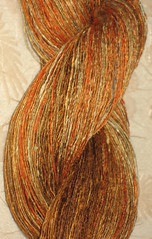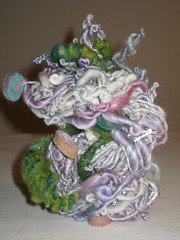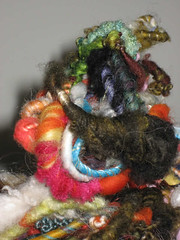So what's with the term "Art Yarn"?
 Art Yarns/Slightly edited from a talk I was asked to give to a spinning guild a couple of years ago.
Art Yarns/Slightly edited from a talk I was asked to give to a spinning guild a couple of years ago.OK, so what is “art yarn”? As I mentioned earlier, I think it’s a loaded phrase. I don’t generally use the term. I don't really see the point of these categories and pigeon holes in life or yarn.
There doesn’t seem to be a consensus among spinners of the definition. Many who spin say they "know them when they see them.” What they are NOT, though, is beginner yarns or mistake yarns, (although I think beginners can also make boundary expanding yarn.)
The “Art Yarn” term has been used in a few different ways.
1. To describe yarn that didn’t turn out the way one expected—“mistake yarn”. It’s sometimes used to make newer spinners feel good about their yarn. Often, people seem to imply that those making some of the wilder yarns don’t have the skills to make “traditional” yarns, which is usually not the case.

2. Yarn that incorporates a lot of doodads, "less traditional" materials—sometimes it’s implied by critics that the yarn is less good, because, in their eyes, it can’t be used. Of course, people do use it for any number of things. Sometimes, these yarns require a very creative approach to working with them. If one knows only
 how to follow patterns, it might be a challenge to imagine how to use them. (A number of books exist that show you how to create with a pattern free/yarn specific approach.)
how to follow patterns, it might be a challenge to imagine how to use them. (A number of books exist that show you how to create with a pattern free/yarn specific approach.)Here’s how I would distinguish the term—it’s yarn that is created intentionally, with a knowledge of what fibers can do and the desire to expand the visual, tactile, and sculptural capacities of yarn. It’s yarn that comes from life experience and is transformed into a physical form. It can be pure art, to exist on its own and/or can be transformed again by someone who uses it to weave, knit, crochet, net with—the possibilities are endless. (And I think it's also often created in a "no intention"/play state of mind.)
As far as I can tell, there’s always been yarn that expanded upon the possibilities of a simple single. Maybe the first “art yarn” was born when some Neolithic spinner saw a slub in her yarn and said, “Screw it—I like it!”. There are beautiful examples of inventiveness from the Incas. They incorporated feathers into their yarns and designed some yarns so that certain decorative effects would occur when they were plaited. In earlier times, there was much greater variety of yarn created than is created in current times. Weavers demanded them!
A number of spinning books from the the 70’s in the U.S. show examples of experimental yarns, addressing the idea that spinning for any length of time would lead one to ask “what if…"? So, in some ways, these yarns that are perceived as less traditional could be seen as belonging to a long tradition.
Many online fora allow opportunities for creating variety in yarns. Over the past 7 - 8 years, you’d have been able to find a lot of experimenting in the following: Live Journal—Fiber Friday community, Crafster forums, The Yarn Museum, Etsy forums and lately, Ravelry. A number of these groups use themes and games to encourage play. Some take off points have been creatures from popular culture, people and cultures from the past, books. So the idea would be to spin your version of Dr. Seuss, your secret crush, the word “celestial”, the idea of a shipwreck, Madonna, Africa...
My personal themes and inspirations have been things like imaginary creatures, spirituality, and films. Sometimes I’ve just wanted to express joy or anger, make a yarn portrait of one of my cats or I’m attracted to a certain fiber and want to see what will happen to it if I spin it in a new way.

 Some sources for inspiring materials: fiber festivals, online retailers, thrift shops, antique shows, button and fabric shops.
Some sources for inspiring materials: fiber festivals, online retailers, thrift shops, antique shows, button and fabric shops.Some techniques to play with: plying, wrapping, coils, boucle, adding beads, combining materials, multiple plies, corespinning, made up/in the moment techniques.
Some sources to work off of: colors (they can provoke such emotional responses), personal interests, landscape, anything that engages ANY of your senses. What is experimental and inspiring to YOU? Working with different fibers, trying a new technique, portray something in a yarn...
Considerations: it might be helpful to NOT think of the use to which a yarn will be put, maybe think less about the structural integrity of a yarn while in experimental phase. Keep an open mind and create with a sense of play.
Capacities of wheels—orifices and hooks can be considerations. But you can be plenty experimental on any wheel! You might have to be a bit more patient to deal with hooks. Spindles have fewer limitations as far as orifice and hooks. Work within your own wheel’s capacity to experiment. Yarns needn’t be spun, but can be created in many other ways.
Finishing yarns: I like to make yarns that will withstand most uses I’ll put them to. I skein, wash and store them as any other yarn I make.
My hope is that we can allow all kinds of yarns to be and that we can appreciate them for whatever qualities they have. And we can appreciate the makers of all the various kinds of yarn, too!
Originally given as talk to spinners who were curious about "art yarns". Posting this now because of some recent discussions with other spinners~
Labels: art yarn, label free, open mindedness, screw categories, spinning


6 Comments:
what an interesting and well written viewpoint about art yarns!
thanks for sharing your thoughts!
Art yarn like the word Art has something pretentious about it, something a true work of art (see small caps :-)) does not have. Well, that's what I think....
tebbis
in addition:
it's human nature to label and define and it helps to have a tag/name/label to eplain the stuff you do or make. So I have no problem with the term Art Yarn, as to describe the techniques.
"Here’s how I would distinguish the term—it’s yarn that is created intentionally, with a knowledge of what fibers can do and the desire to expand the visual, tactile, and sculptural capacities of yarn. It’s yarn that comes from life experience and is transformed into a physical form. It can be pure art, to exist on its own and/or can be transformed again by someone who uses it to weave, knit, crochet, net with—the possibilities are endless. (And I think it's also often created in a "no intention"/play state of mind.)"
You are a genius. I think this is the best description I have read.
thanks to those of you who commented. always great to hear other thoughts and know that we are all free to think as we want :)
glad the words spoke to you, holly!
Love your reflections on art yarns.
Love your yarns.
Post a Comment
<< Home